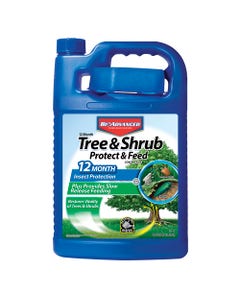

- Home
- Solution Center
- Learn
- Learn: Tree & Shrub
- Tree Care: Are Your Trees Safe?
Tree Care: Are Your Trees Safe?
Mature trees increase property value by as much as 10 percent, according to the U.S. Forest Service. But a tree can shift from asset to liability when branches, trunks or roots suffer injury, insect damage or diseases, and threaten to cause property or personal damage.
By inspecting trees and addressing potential problems, you can protect your home, save lives, and safeguard the investment that healthy trees add to your property. Not sure where to begin? Use our checklist to identify possible hazards in tree growth and development. If you notice any of these problems, consult with a certified arborist to determine tree health and solutions.
Check Branches – Remove dead or damaged wood as soon as possible. Here are some tips on pruning. Hire a certified arborist to remove branches located high within a tree canopy, as well as to inspect trees with narrow crotch angles or multiple upright stems, which are weaker and more prone to breaking. Pruning large trees can be dangerous and should be left to professionals.
- Look for dead, broken or dangling branches, or cracks where branches attach to the trunk.
- Branches that are missing bark or growing fungus can be signs of decaying wood and potential structural problems.
- Narrow crotch angles where branches attach to trunk; a common occurrence with elm and maple trees.
Check Trunks – Trunk problems can diminish a tree’s stability. The exterior of a tree may appear fine except for a small crack, cavity or fungus, while the interior may be rotted, soft or even empty. A certified arborist has the tools to inspect the trunk’s interior and determine trunk health.
- Look for cracks or cavities in the trunk.
- Also look for oozing or bleeding wounds, as well as cankers with sunken or missing bark
- Mushrooms or fungal growth can also be a sign of decay and structural weakness.
Check Roots – There are two types of roots, anchoring and absorbing. Anchoring roots are big, woody roots that support the tree, some of which may be visible above ground. When anchoring roots are damaged, the tree can appear healthy with green leaves. It may lean – or not. But compromised anchors mean even a gentle wind or the weight of rainwater can topple the entire tree. Absorbing roots absorb water and nutrients from soil. When absorbing roots are damaged, the problem usually manifests above ground as small or discolored leaves.
- Fungus or mushroom growth on large anchoring roots, along the base of the trunk, or on soil near the tree can indicate decay.
- Cavities or hollows near the base of the tree or in large roots can also be a sign of trouble.
- Cracked or raised soil on one side of a tree trunk could indicate the start of leaning and weakness.
- New construction and soil compaction can also damage roots.
Check Leaves – As spring progresses, the tree should leaf out evenly with healthy looking foliage. Most mature trees need very little fertilizer but specific nutrient deficiencies indicated by poor or uneven foliage color may need to be corrected.
- Uneven coloring or slow growth in portions of the tree may be signs of problems.
Check For Insect Damage – Some insects, like Japanese Beetles cause obvious superficial damage to your tree. Mature trees can often recover from this type of infestation. However other insects, like the invasive Emerald Ash Borer, cause subtle visible damage, but can kill the entire tree in just a few years. Inspecting for signs of insect presence or damage can prevent problems in the future, and may even save your tree.
- Look for leaves with holes, that are yellowed or curled, or have been skeletonized.
- Check trunks and branches for entry or exit holes, bark that peels back easily, or tunnels underneath bark.
- Sticky Honeydew is produced by small sucking insects, such as Aphids, feeding on your tree. Insects like Ants and Wasps feed on Honeydew, their presence may indicate an unseen problem.
One application of BioAdvanced™ 12 Month Tree & Shrub Protect and FeedII* protects trees from pests like Borers, Aphids, Scales, Whiteflies and others for up to 1 year. Choose from either Concentrates or Granules, with both there’s no spraying! Simply apply it around the base of your tree for systemic protection from the roots to the tip of every leaf.
*Not for sale in NY. Reclassified as restricted use in CT & MD.















